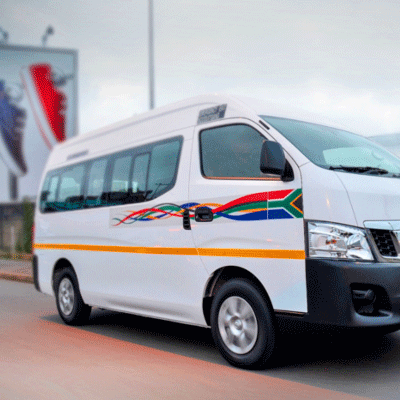The taxi industry is ready to be disrupted, and young people are the key. This is the message of Maroba Maduma, SA Taxi communications executive.
SA Taxi is an independent financer of minibus taxis and a developmental credit provider. One of their areas of focus is developing the taxi industry and ensuring its sustainability.
Their most recent efforts saw them launch a skills certification for taxi rank technicians, Project Refentse, which “upskills young mechanics by giving them formal theoretical and practical training, but also by providing them with tools for carrying out their trade when they are done with the course”. They have also previously provided incubation support services to meter taxi owner-drivers and supported local emerging artists and designers through the SA Taxi Foundation.
In addition to the need for trainers, accountants, and management specialists, there is enormous scope for IT, marketing, business development, and business innovation professionals who can grow the industry into the future
The organisation believes it has a responsibility to develop the industry, says Maduma.
“As a value chain facilitator, we at SA Taxi and the SA Taxi Foundation, apply our specialised technology, financial, and business insights and capabilities to helping the industry address the sustainability needs it identifies.
“We believe the private sector has a responsibility to keep evolving the skills within the industry and, in the process, supporting the future of an industry that supports the entire economy.”
However, youth participation is needed, says the 33-year-old Maduma, young people who are eager to take advantage of opportunities within the industry, from mobile payments and access to information for customers to fleet management and revenue tracking and safety.

Maduma speaks to SME South Africa about what’s needed to attract young people into the taxi industry and the role of technology in the industry’s future.
The taxi industry has always been entrepreneurial
Where there is a need for people to go from one point to another, there is always a taxi owner who takes the initiative to transport them. He or she does route planning based on the most petrol-efficient route that can deliver the most people as close as possible to their destination. They hire staff, form associations, put up signage, do pricing and, at the end of the day, count profits.
What else can we call them but entrepreneurs?
These are good businessmen and women who directly create 1.8 jobs per minibus taxi, helping in their way to solve the serious issue of unemployment in our country.
The industry is a major economic contributor
Few people realise that the industry rests entirely on the backs of small businesses run exclusively by local entrepreneurs. Young people simply don’t know that every minibus taxi is a business opportunity on wheels.
Also, owning or driving a taxi in all [types of] weather at all times of the day or night may not seem as glamorous or fashionable as working with a computer in a high-rise building in a big city. One doesn’t often see television or online adverts of chic young people driving minibus taxis.
There is also little understanding of the socio-economic contribution the industry makes to society. Young people wanting to make a difference don’t realise they can do it through the industry.
That said, we are seeing growing numbers of young people in our SA Taxi Finance book – 16% of our total book is under the age of 35 years and performing well.
Attracting young talent – professionals and entrepreneurs
There are other opportunities in the industry, some of which will appeal to those with a pioneering spirit. The industry is in an evolutionary phase.
So, in addition to the need for trainers, accountants, and management specialists, there is enormous scope for IT, marketing, business development, and business innovation professionals who can grow the industry into the future.
Young people wanting to make a difference don’t realise they can do it through the industry
Opportunities within the industry which are ripe for the picking
The world is growing into a globalised, self-service, on-demand, data-driven, customer experience-dominated environment in which the reduction of customer effort and personalisation of services will differentiate a business from its competitors and, crucially, set customer expectations for every industry.
With this comes a vast array of opportunities to innovate in how people hail taxis, how owners understand their profitability, and what the taxi of the future should look like. It will ramify through to the way the government considers infrastructure for land transport – including self-driving vehicles. We’re going to need daring, business-minded people who can design management tools for taxi fleet owners, human resource strategies specific to this fluid industry, route management technology etc.
Challenges do exist
Yes, of course, there are issues. But this is a pro-active industry determinedly trying to resolve some fairly intractable historical, policy, and regulatory challenges. They cannot be resolved in isolation. Collaboration across the full stakeholder spectrum is essential. Inherently, that’s a slow process. In the meantime, every day, against the odds, operators have to get on with the job of transporting people safely, efficiently, and affordably.
The industry’s two mother bodies, SANTACO and the NTA work tirelessly to build the bridges from the informal to the formal sector needed to make the industry sustainable in a world now dominated by digital, mobile, and social technologies.
It’s a matter of communication. As in any other industry – and sphere of life – negative incidents receive a disproportionate amount of publicity. In the absence of positive information, all stakeholders suffer from justifiable public abhorrence of incidents of violence and anti-social driving. It’s worth bearing in mind, however, that fewer than 10% of the ~900 taxi associations around the country daily delivering 15 million commuters to work and school ever endure disruptive behaviour.
The industry’s resilience is legendary
.. but there are good stories to tell
We have linked our business success inextricably to that of the industry. The fact that it would be reckless business practice for us to commit our stakeholders to a dysfunctional industry gives you an indication of just how well the industry does function, despite its challenges. If we can trust it, so can everyone else.
The minibus taxi industry is functional to a degree that would be remarkable in the formal sector with all its sophisticated business models and management practices. When you consider that the minibus taxi industry is almost entirely cash-based and is founded on the activities of hundreds of thousands of micro-entrepreneurs who, mostly, have no formal business or management training, you get a sense of the integrity and capability that underpins an industry that is the lifeblood of the entire national economy.
That’s a good news story that is seldom told.
Increasing efficiency is the future
In a digital world in which relentless innovation is the norm, the future of the industry is essentially a field of opportunities. It may or may not include driverless vehicles if the manufacturers get it right and the government, the private sector, and the industry collaborate on the single objective of maintaining the industry’s sustainability.
But, long before that becomes a reality, owners, associations, and all other stakeholders will continue to find ways for people to reach their destinations most effectively. The industry’s ride into the future is bound to have some bumps and unexpected detours. But the industry’s resilience is legendary. We’ll get there, together.
The taxi industry’s tech future
Technology is becoming the basis of customer experience. It therefore impacts the industry’s future on multiple levels, from managing businesses more efficiently to making life easier for the commuter.
As just one example, SA Taxi Protect is already using analytics via telematics to help taxi owners better manage their fleets. Also, once implemented in the industry, real-time accident impact notifications and digital assessments will lead to faster insurance claim turnaround times, putting the owner’s business asset back on the road faster.
The industry understands that technology offers extraordinary benefits and is alert to opportunities for inclusive development and progress.






